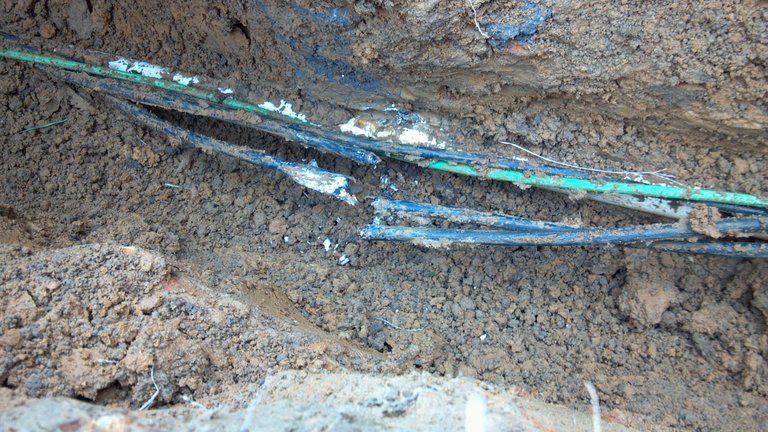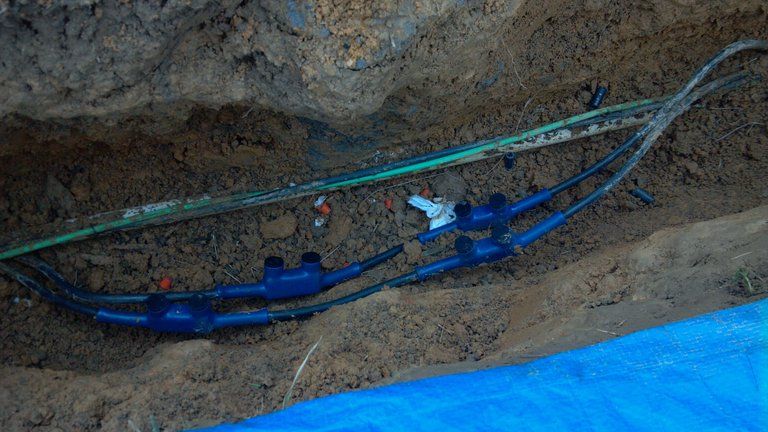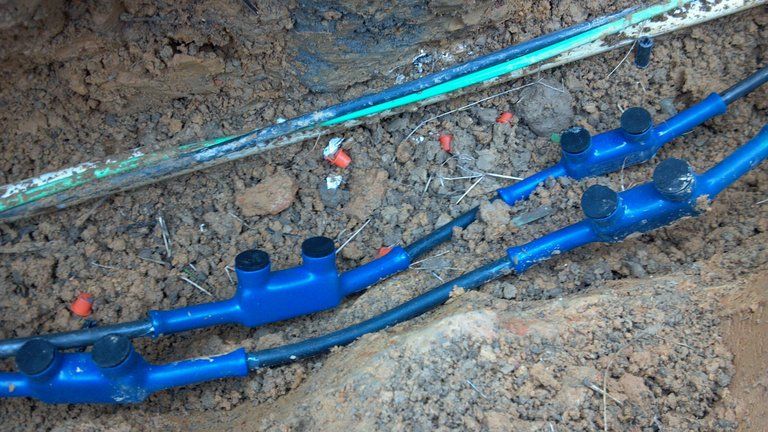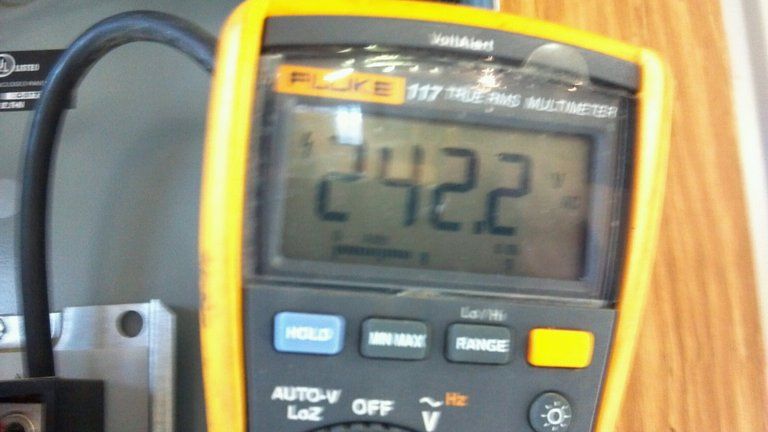You are using an out of date browser. It may not display this or other websites correctly.
You should upgrade or use an alternative browser.
You should upgrade or use an alternative browser.
Megging Question
- Thread starter Little Bill
- Start date
- Status
- Not open for further replies.
- Location
- Tennessee NEC:2017
- Occupation
- Semi-Retired Electrician
I may have missed something, but I think you determined you have an open ungrounded conductor somewhere.
Easy way to determine this would have been to connect a reasonably heavy 120 volt load to each line and check voltage readings. The good line will have only a little voltage drop, the bad line with that kind of a load often will drop to nearly nothing and the load will not operate. A 1200-1500 watt heater works well as a test load.
If you have 240 volt loads in an outbuilding like that and an open ungrounded conductor in the feeder, the 240 volt loads will confuse you with voltage readings as you will get feed thru the 240 load to make the open line look like it is mostly working, turn the 240 volt load(s) off and then everything on the bad leg quits working altogether.
If you're talking about voltage readings they were taken with and without loads. There was about a 1 volt drop with just the lights that were on the good leg on. With the small water tank heater and the lights on there was a 2 volt drop. I had the 240V water heater turned off at the breaker and later just disconnected. Voltage at the bad leg at sub stayed around 72V with loads connected, but nothing actually worked. No phantom voltage as it didn't drop out when tested with loads connected.
I didn't have the 240V load on when checking and even disconnected and checked again.
The bad leg didn't have any receptacles on it, just lights and of course half the 240V water heater.
I think I stated this, but without going back to check, I will state it again. I put all the loads (except the 240V water heater) on the good leg so they could have lights.
I am going to re-feed the barn. It wouldn't serve any purpose digging up the feed, especially the paved drive, to find the fault.
I was just confused with why I didn't show at least a lower resistance on the bad conductor to either ground or neutral. But I'm guessing after thinking about it, the neutral or ground would also have to have a break in it.
kwired
Electron manager
- Location
- NE Nebraska
- Occupation
- EC
there are locators that will find such a break in the line without having to dig the whole thing up.I didn't have the 240V load on when checking and even disconnected and checked again.
The bad leg didn't have any receptacles on it, just lights and of course half the 240V water heater.
I think I stated this, but without going back to check, I will state it again. I put all the loads (except the 240V water heater) on the good leg so they could have lights.
I am going to re-feed the barn. It wouldn't serve any purpose digging up the feed, especially the paved drive, to find the fault.
I was just confused with why I didn't show at least a lower resistance on the bad conductor to either ground or neutral. But I'm guessing after thinking about it, the neutral or ground would also have to have a break in it.
- Location
- Placerville, CA, USA
- Occupation
- Retired PV System Designer
Very good except for the symptom that leg to leg voltage was 190.
That would not be a crossover through the 240 volt load, since that would have been in phase and would not add.
Tapatalk...
That would not be a crossover through the 240 volt load, since that would have been in phase and would not add.
Tapatalk...
- Location
- Tennessee NEC:2017
- Occupation
- Semi-Retired Electrician
there are locators that will find such a break in the line without having to dig the whole thing up.
As far as locating the fault. I know there are locators that can find it. But I don't own one, don't know anyone that does. If I had to pay someone to do it and then find it is under the paved drive, that would be as much or more than just re-feeding it.
Very good except for the symptom that leg to leg voltage was 190.
That would not be a crossover through the 240 volt load, since that would have been in phase and would not add.
Tapatalk...
I'm guessing that there might also be damage to the other ungrounded conductor. That and the voltage drop for the distance, is another reason I'm going to re-feed it.
kwired
Electron manager
- Location
- NE Nebraska
- Occupation
- EC
Very good except for the symptom that leg to leg voltage was 190.
That would not be a crossover through the 240 volt load, since that would have been in phase and would not add.
Tapatalk...
Need to know what load conditions were. It possibly was a reading of 240 volts less the drop in the problem spot. Add some load from the lost line to neutral and you will make the problem spot more obvious.
kwired
Electron manager
- Location
- NE Nebraska
- Occupation
- EC
I could locate it, but you may not want someone to have to come that kind of distance for thisAs far as locating the fault. I know there are locators that can find it. But I don't own one, don't know anyone that does. If I had to pay someone to do it and then find it is under the paved drive, that would be as much or more than just re-feeding it.
I'm guessing that there might also be damage to the other ungrounded conductor. That and the voltage drop for the distance, is another reason I'm going to re-feed it.
I assume you are planning an alternate route instead of under the pavement, or directional boring that part
- Location
- Tennessee NEC:2017
- Occupation
- Semi-Retired Electrician
I could locate it, but you may not want someone to have to come that kind of distance for thisBefore you go to too much trouble you should maybe at least dig up each end of the run and see what you find, there seems to be a lot of failures right near the point where the conductors turn to emerge from underground.
I assume you are planning an alternate route instead of under the pavement, or directional boring that part
The end that turns up into the barn is under the paved drive.
Yes, I plan on going a different route that doesn't go under the drive.
pjholguin
Senior Member
I had the same problem at house in the NW of New Mexico...same symptoms...I just replaced the feeder. I did a bit more looking around at the lot and found several newly planted trees...What I am saying look for changes in the landscape and that should give a pretty good idea where to look for the problem; I found that a shovel had nicked the insulation and corrosion killed the Al conductors. But in the end replacing the feeders was best, went from DB cable to conduit. Much better in my eyes.
PJHolguin
PJHolguin
The end that turns up into the barn is under the paved drive.
Yes, I plan on going a different route that doesn't go under the drive.
- Location
- Tennessee NEC:2017
- Occupation
- Semi-Retired Electrician
I had the same problem at house in the NW of New Mexico...same symptoms...I just replaced the feeder. I did a bit more looking around at the lot and found several newly planted trees...What I am saying look for changes in the landscape and that should give a pretty good idea where to look for the problem; I found that a shovel had nicked the insulation and corrosion killed the Al conductors. But in the end replacing the feeders was best, went from DB cable to conduit. Much better in my eyes.
PJHolguin
I have a strong suspicion that the damage is under the paved drive since it was put in after the feeder.
Don't know if the insulation was nicked when installed and/or the driveway has settled and maybe rocks pushing down on them.
- Location
- Tennessee NEC:2017
- Occupation
- Semi-Retired Electrician
Update
Update
I don't think I updated the info I got after my OP.
1). Found out that the 100A breaker that feeds the sub panel had tripped a couple of times. Something he failed to tell me when I was there.:rant:
2). Went back and disconnected the bad leg so there would be no line fault.
3). A few weeks later the power was lost completely to the barn.
4). Found out the HO had a fence put in just a few months ago. Information that would have been good to know to start with.
Anyway, I decided to try something because of the fence info I got. I looked where the feeder came out from the house and you could see where the trench was. It had settled and was a little lower than the other ground so you could see the path it took.
The path from the house headed straight towards a fence post about 15' away.
Here's what I decided to try. Since I don't own a locator, I improvised.
I took my toner and connected it to the two line conductors for the feed at the main panel. Then I went outside and put the toner probe close to the ground and started following the trench path.
I could just faintly hear the tone, but it was there. When I got to the fence post the tone got loud and just past the post I got nothing. So I thought this has definitely got to be where the break is.
I told the HO what I found and he decided it would be worth a shot to dig up a small area around the fence post. He said he would do the digging (I was fine with that! )
)
He called me after he was finished digging so I went to look. Sure enough that was where the break was. I'm thinking that the damage was done by the auger that was used to dig the holes for the post
Here are a few pictures of what I found and the repairs I made.





Update
I don't think I updated the info I got after my OP.
1). Found out that the 100A breaker that feeds the sub panel had tripped a couple of times. Something he failed to tell me when I was there.:rant:
2). Went back and disconnected the bad leg so there would be no line fault.
3). A few weeks later the power was lost completely to the barn.
4). Found out the HO had a fence put in just a few months ago. Information that would have been good to know to start with.
Anyway, I decided to try something because of the fence info I got. I looked where the feeder came out from the house and you could see where the trench was. It had settled and was a little lower than the other ground so you could see the path it took.
The path from the house headed straight towards a fence post about 15' away.
Here's what I decided to try. Since I don't own a locator, I improvised.
I took my toner and connected it to the two line conductors for the feed at the main panel. Then I went outside and put the toner probe close to the ground and started following the trench path.
I could just faintly hear the tone, but it was there. When I got to the fence post the tone got loud and just past the post I got nothing. So I thought this has definitely got to be where the break is.
I told the HO what I found and he decided it would be worth a shot to dig up a small area around the fence post. He said he would do the digging (I was fine with that!
He called me after he was finished digging so I went to look. Sure enough that was where the break was. I'm thinking that the damage was done by the auger that was used to dig the holes for the post
Here are a few pictures of what I found and the repairs I made.





- Location
- Tennessee NEC:2017
- Occupation
- Semi-Retired Electrician
Is that a broken pipe,or just wires run under ground?:slaphead:
It's wires and a water pipe, but only 2 of the wires were cut/broke!
Triplex direct burial? :huh:It's wires and a water pipe, but only 2 of the wires were cut/broke!
- Location
- Tennessee NEC:2017
- Occupation
- Semi-Retired Electrician
Triplex direct burial? :huh:
No, it's 4-wire direct burial.
I don't count the EGC. Guessing something like RHH/RHW/USE triple-rated cable.No, it's 4-wire direct burial.
Last edited:
- Location
- Tennessee NEC:2017
- Occupation
- Semi-Retired Electrician
I don't count the EGC. Guessing something like RHH/RHW/USE triple-rated cable.
We don't call the four conductor "triplex". That is usually the overhead 3-conductor (2 ungrounded and one grounded)
You're correct in the type. This actually says......XLPE USE-2, RHH or RHW-2
With no pipe.....:happysad:No, it's 4-wire direct burial.
- Location
- Tennessee NEC:2017
- Occupation
- Semi-Retired Electrician
With no pipe.....:happysad:
Sure there is, it's white and full of water!:lol:
That is, contains the liquid neutral... :lol:Sure there is, it's white and full of water!:lol:
- Status
- Not open for further replies.

